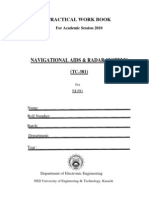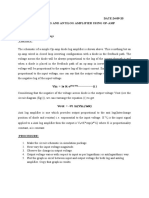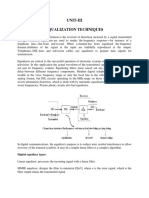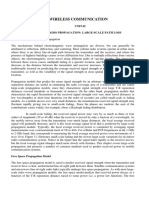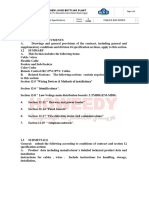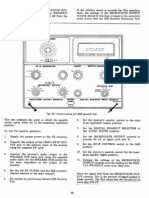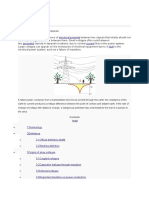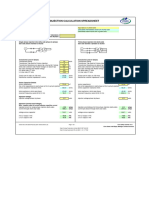Small Signal Analysis of Amplifiers (BJT & Fet) : Narayana Engineering College:: Nellore
Small Signal Analysis of Amplifiers (BJT & Fet) : Narayana Engineering College:: Nellore
Uploaded by
Tharun kondaCopyright:
Available Formats
Small Signal Analysis of Amplifiers (BJT & Fet) : Narayana Engineering College:: Nellore
Small Signal Analysis of Amplifiers (BJT & Fet) : Narayana Engineering College:: Nellore
Uploaded by
Tharun kondaOriginal Title
Copyright
Available Formats
Share this document
Did you find this document useful?
Is this content inappropriate?
Copyright:
Available Formats
Small Signal Analysis of Amplifiers (BJT & Fet) : Narayana Engineering College:: Nellore
Small Signal Analysis of Amplifiers (BJT & Fet) : Narayana Engineering College:: Nellore
Uploaded by
Tharun kondaCopyright:
Available Formats
NARAYANA ENGINEERING COLLEGE:: NELLORE
Approved by AICTE and Permanently Affiliated to JNTUA, Ananthapuramu,
An ISO 9001:2008 Certified Institution, Recognized by UGC U/S 2(f) & 12(B) and „A‟ grade by Govt. of AP.
Muthukur Road, Nellore-524004
DEPARTMENT OF ELECTRONICS AND COMMUNICATION ENGINEERING
Course: B.TECH II Year II SEM ACY: (2020-2021)
SUB: ELECTRONIC CIRCUIT ANALYSIS & DESIGN Th Tu C
3 1 3
Branch/Section: ECE/A&B Faculty: S.Girish Gandhi
UNIT-I
SMALL SIGNAL ANALYSIS OF AMPLIFIERS (BJT & FET)
1. Define h parameters?
One of a set of four transistor equivalent-circuit parameters that conveniently specify
transistor performance for small voltages and currents in a particular circuit. Also known as
hybrid parameter.
2. Give the hie and heo equations of BJT?
h11 = hie - The input impedance of the transistor (corresponding to the emitter resistance
re).Unit ohms Ώ.
h22 = hoe - The output impedance of transistor. This term is usually specified as admittance and
has to be inverted to convert it to impedance. Units’ siemans S.
2. Define amplifier
A device which accepts an input signal and produces an output signal proportional to the
input is called an amplifier.
3. List out the some features of a differential amplifier?
High differential voltage gain. Low common mode gain.
High CMRR.
Two input terminals. High input impedance.
Large bandwidth.
Low offset voltages and currents.
Low output impedance.
5. Explain the ideal characteristics of voltage amplifier?
Infinite Open Loop Gain, Infinite Input Impedance, Zero Output Impedance,
Infinite Bandwidth, Zero Output Offset, and Zero Noise Contribution.
6. Explain about CS Amplifier?
The CS amplifier is a small signal amplifier. For good bias stability, the source
resistor voltage drop should be as large as possible. Where the supply voltage is small, Vs
may be reduced to a minimum to allow for the minimum level of Vds.R2 is usually selected
as 1M Ώ or less as for BJT capacitor coupled circuit coupling and bypass capacitors should
be selected to have the smallest possible capacitance values. The largest capacitor in the
circuit sets the circuit low 3dB frequency (capacitor C2). Generally to have high input
impedance FET is used. As in BJT circuit RL is usually much larger than Z o and Zi is often
much larger than
7. What is stability factor?
Stability factor is defined as the rate of change of collector current with respect to the rate of
change of reverse saturation current.
8. What is biasing?
To use the transistor in any application it is necessary to provide sufficient voltage and
current to operate the transistor. This is called biasing.
9. What are the requirements for biasing circuits?
• The q point must be taken at the Centre of the active region of the output characteristics
.• Stabilize the collector current against the temperature variations.
• Make the q point independent of the transistor parameters.
• When the transistor is replaced, it must be of same type.
10. List out the different types of biasing.
Voltage divider bias, Base bias, Emitter feed back bias, Collector feedback bias, Emitter
bias.
11. What do you meant by thermal runway?
Due to the self heating at the collector junction, the collector current rises. This causes
damage to the device. This phenomenon is called thermal runway.
12 . Why is the BJT called a current controlled device?
The output characteristics of the BJT depend on the input current. So the BJT is called a
current controlled device.
13. Why do we choose q point at the center of the load line?
The operating point of a transistor is kept fixed usually at the center of the active region in
order that the input signal is well amplified. If the point is fixed in the saturation region or the
cut off region the positive and negative half cycle gets clipped off respectively.
14.Define the stability factors S’ and S’’ ?
The Stability factor S’ is defined as the rate of change of Ic with VBE
keeping ICO and constant.
The Stability factor S’’ is defined as the rate of change of Ic with
keeping VBE and ICO constant.
15. Write the CE amplifier Current gain, Voltage gain, Input Impedance, Output Impedance in terms
of h-parameters.
Current gainAi = -hfe Voltage gainAv = ( - hfeRL)/hie Input Impedance Zi = hie
Output Impedance Zo = ( hfe+Rs)/(hoeRs + h)
16. Which amplifier is called as voltage follower? Why?
The common collector transistor amplifier configuration is called as voltage follower. Since it has
unity voltage gain and because of its very high input impedance. It doesn’t draw any input current
from the
signal. So, the input signal is coupled to the output circuit without making any distortion.
17.What are the salient features of hybrid parameters?
The salient features of hybrid parameters are, a. h parameters are real numbers,
b. They are easy to measure.
c. They are convenient to use in circuit analysis and design d. Easily convertible from one
configuration to other
e. Readily supplied by manufactures.
18.What are the limitations of h parameters?
The h parameters has the following limitations,
a. The accurate calculation of h parameters is difficult.
b. A transistor behaves as a two port network for small signals only, hence h parameters can be used
to analyze only the small signal amplifiers.
19.What is meant by unity gain frequency?
The frequency at which the gain approaches unity is known as unity gain frequency.
20. Give the condition for analyzing the simplified Hybrid model of the transistor amplifier?
The following condition should be satisfied for analyzing the simplified hybrid model of transistor
amplifier.
hoe.RL<0.1
UNIT –II
FREQUENCY RESPONSE
1. Define the frequency response of Amplifier.
The frequency response of an amplifier can be defined as the variation of output of quantity
with respect to input signal frequency. In otherwise it can be defined as a graph drawn
between the input frequency and the gain of an amplifier.
2. Define lower & upper cut off frequencies of an amplifier.
Lower cut-off frequency
The frequency (on lower side) at which the voltage gain of the amplifier is exactly
70.0% of the maximum gain is known as lower cut off frequency.
Upper cut-off frequency
The frequency (on higher side) at which the voltage gain of the amplifier is exactly
70.0% of the maximum gain is known as upper cut off frequency.
3. Define bandwidth
The range of frequencies over which the gain remains constant
Bandwidth = Upper cut-off frequency - Lower cut-off frequency
BW = fH - fL
4. State the reason for fall in gain at low frequencies.
The coupling capacitance has very high reactance at low frequency. Therefore it will allow
only a small part of signal from one stage to next stage and in addition to that the bypass
capacitor cannot bypass or shunt the emitter resistor effectively. As a result of these factors,
the voltage gain rolls of at low frequency.
5. State the reason for fall in gain at higher frequencies
At high frequency the reactance of inter electrode capacitor is very low. Therefore it behaves
like a short circuit. As a result of this the loading effect of the next stage increase which reduces
the voltage gain. Hence the voltage gain rolls off at high frequencies
6. Why the electrolytic capacitor is not used for coupling?
Electrolytic capacitor is a polarized capacitor. So it cannot be used for coupling and also in
electrolytic capacitor, the dielectric is not an insulating material but it conducting material
which will change the capacitance effect.
7. Write a note on effects of coupling capacitor.
a. The coupling capacitor Co transmits AC Signal. But blocks Dc. This prevents DC
interferences between various stages and the shifting of operating point.
b. It prevents the loading effect between adjacent stages.
8. What is dominant network?
In high frequency analysis of an amplifier, the network having lower critical frequency is
called dominant network.
9. Give the relation between fT and fβ .
fT = hfe * fβ
10. Why an NPN transistor has a better high frequency response than the PNP transistor?
An NPN transistor has a better frequency response than the PNP transistor because the
mobility of electron is more and capacitive effect is less.
11. For an amplifier, midband gain is 100 and lower cut off frequency is 1kHz. Find the gain of
an amplifier at the frequency of 20Hz.
A = (Amid)/( (1+(f1/f2)2))
A = (100)/( (1+(1000/20)2)) = 2
12. What is the significance of gain bandwidth product?
It is very helpful in the preliminary design of a multistage wideband amplifier.
This can be used to setup a tentative circuit, which is often used for this purpose.
13. Why is the gain bandwidth product a constant?
It is defined as the magnitudes of the product of the mid band gain which is a constant and
the bandwidth, which is also a constant. Hence the product of two constants should also
be a constant.
14. Write the relation between the bandwidth and rise time of an amplifier
BW=fH = 0.35/tr
15. Define fT and fβ .
Unity gain frequency (fT) or frequency parameter.
It is defined as the frequency at which the common emitter shirt circuit current gain
has dropped to unity and is denoted by the symbol (fT)
Beta cut-off frequency ( fβ)
It is defined as the high frequency at which -of a CE transistor drops to 0.707 or
3dB from its lower frequencies
16. What is the need for having a high value of fT?
Bandwidth of the amplifier is directly proportional to f T. hence tp have larger bandwidth,
the value of fT should be high.
17. What is a cascade amplifier?
The cascade configuration is an amplifier composed of n number of stages. This offers large
gain and lesser bandwidth.
18. What are the advantages of representation of gain in decibels?
a. In multistage amplifier, it permits to add individual gains of the stages to calculate
overall gain.
b. It allows us to denote, both very small as well as very large quantities of linear scale
by considerably small figures.
19. What is the coupling methods used for coupling in multistage amplifiers?
The coupling methods used are,
a. RC coupling
b. Transformer coupling
c. Direct coupling
20. Draw the hybrid- model of a transistor in the CE configuration (high frequency model)
UNIT-III
MULTI STAGE & DIFFERENTIAL AMPLIFIERS
1. What are the advantages of Darlington Circuit?
i Very high current gain
ii Very high input impedance
iii Convenient and easy circuit configuration to use
iv Darlington pairs are widely available in a single package or they can be made from
two separate transistors
2. Define miller’s theorem
Miller’s theorem states hat the effect of resistance Z on input circuit is a ratio of input
voltage to the current I which flows from input to output.
Miller’s theorem states that the effect of resistance Z on Output circuit is a ratio of output
voltage to the current I which flows from output to input.
3. What are the coupling schemes used in multistage amplifiers?
The commonly used coupling schemes are,
a) Resistance Capacitance (RC) coupling
b) Transformer coupling
c) Direct coupling
4. Why hybrid parameters are called so? Define them. [OR] Define the various h-parameters?
The dimensions of the hybrid parameters are not alike, that is they are hybrid in nature, so
They are called hybrid parameters.
h11= Input impedance with output port short circuited.
h12= Reverse voltage transfer ratio with input port open circuited.
h21= Forward current gain with output port short circuited.
h22= Output admittance with input port open circuited.
5. Define Miller effect input capacitance
For any inverting amplifier, the input capacitance will be increased by a miller effect
capacitance, sensitive to the gain of the amplifier and the inter electrode capacitance
connected between the input and output terminals of the active device.
C = Inter electrode capacitance between input and output.
6. What is meant by bootstrapping?
In Darlington transistor pair circuits, the input impedance is reduced because of the biasing
resistors in the circuit. To overcome this, decrease in the input resistance due to the biasing
network, a small capacitor and resistance R3 are added in the circuit. This improves the
input impedance of the Darlington pair circuit. C is added at the input side and R3 is
connected between output and input circuits.
7. Why emitter bypass capacitor Ce is used in CE amplifier circuit.
An emitter bypass capacitor Ce is connected in parallel with the emitter resistance R E to
provide a low reactance path to the amplified ac signal. If it is not inserted, the amplified
ac signal passing through RE will cause a voltage drop across it.
This will reduce the output voltage, reducing the gain of the amplifier
8. What are the salient features of hybrid parameters?
The salient features of hybrid parameters are,
a) h-Parameters are real numbers in audio frequency range.
b) They are easy to measure.
c) They are convenient to use in circuit analysis and design.
d) Easily convertible from one configuration to other.
e) Readily supplied by manufacturers.
9. What are the limitations of h-parameter?
a) The accurate calculation of h parameter is difficult.
b) A transistor behaves as a two port network for small signals only,
hence ‘h’ parameter can be used to analyze, only the small signal amplifier.
10. What is an emitter follower?
In the common collector circuit emitter terminal follows the signal voltage applied to the
base. Hence the common collector circuit is also known as an emitter follower.
11. What is the function of Input capacitor C1 in CE amplifier circuit?
This capacitor couples the signal to the base of the transistor. It blocks any dc
component present in the signal and passes only ac signal for amplification.
12. What is the need for output coupling capacitor C2?
The coupling capacitor C2 couples the output of the amplifier to the load or to the next stage
of the amplifier. It blocks dc and passes only ac part of the amplified signal.
13. What is cascade amplifier?
The cascade configuration is an amplifier stage composed of a direct coupled common
emitter/ common base combination. This offers the possibility of a very large bandwidth.
14. What are the high frequency effects?
At high frequencies the internal capacitances, commonly known as junction capacitances
reducing the circuit gain.
15. Write the overall lower cut-off frequency of multistage amplifier.
1
| A 0 L| = fL 2 n
√ [1+( )
f
]
fL= Lower 3 dB frequency of identical cascaded stages.
n = Number of stages.
f= Higher 3db frequency of single stage.
16. Write the overall higher cut-off frequency of multistage amplifier.
1
| A 0 H| = f 2n
√ [1+
( )
fH
]
fH= Higher 3 dB frequency of identical cascaded stages.
n = Number of stages.
f= Higher 3db frequency of single stage.
17. What is significance of gain bandwidth product?
It is very helpful in the preliminary design of a multistage wide band amplifier. This can be
used to setup a tentative circuit which is often used for this purpose.
18. Write a note on effects of coupling capacitor.
a) The coupling capacitor C0 transmits AC signal. But blocks DC. This prevents DC
interference between various stages and the shifting of operating point.
b) It prevents the loading effect between adjacent stages.
Coupling capacitors are used to couple different stages so as to prevent DC from the
o/p of one stage to go into the i/p of the next stage. For instance in coupling two BJT (bipolar
junction transistors) it is required to use coupling capacitor to allow only ac signal from the
o/p of first stage to go to i/p of next BJT as incoming dc can disturb the biasing of the other
BJT.
Bypass capacitors are used to bypass the ac signal to ground. A capacitor is connected
b/w the gnd and the wire. For ac signal capacitor will behave as short and will bypass it.
However dc will not be bypassed as capacitor will behave as open for DC.
19. Write an expression for the bandwidth of multistage amplifier.
The bandwidth of multistage amplifier is
20. What are the advantages of representation of gain in decibels?
a) In multistage amplifier, it permits to add individual gains of the stages to calculate
overall gain.
b) It allows us to denote, both very small as well as very large quantities of linear scale by
considerably small figures.
UNIT 4
FEEDBACK AMPLIFIERS AND OSCILLATORS
1. Define Feedback connection in amplifiers.
A portion of the output signal is taken from the output of the amplifier and is combined
with the input signal is known as feedback.
2. Define positive feedback
If the feedback signal is in phase with input signal, this type of feedback is said to be positive
or regenerative feedback.
3. Define negative feedback
If the feedback signal is out of phase with the input signal, this type of feedback is known as
negative or degenerative feedback.
4. Define sensitivity
Sensitivity is defined as the ratio of percentage change in voltage gain with feedback to
the percentage change in voltage gain without feedback.
5. List the types of feedback
i. Voltage-series feedback
ii. Voltage-shunt feedback
iii. Current-series feedback
iv. Current-shunt feedback
6. Write the expression for input and output resistance of voltage series feedback amplifier
Vs V Ro
Rif = = Ri(1+aß) Rof = =
Ii I (1+a ß )
7. Give an example for voltage-series feedback.
The Common collector or Emitter follower amplifier is an example for voltage
series feedback.
8. Give the properties of negative feedback.
Reduces the gain, stability increases, bandwidth increases, Distortion and noise reduces.
9. What is Oscillator circuit?
An electronic circuit that produces a periodic, oscillating electronic signal, often a sine wave
or a square wave is called an oscillator.
10. What are the types of oscillators?
* RC-Oscillator
i. RC phase shift oscillator
ii Wein bridge oscillator
* LC-Oscillators
i. Hartley Oscillator
ii. Colpitts Oscillator
iii. Crystal Oscillator
iv. Clap Oscillator
11. What are the conditions for oscillations?
Loop gain should be greater than or equals to 1and loop phase shift should be 0 or 360 o
12. Define Piezoelectric effect.
Piezoelectric Effect is the ability of certain materials to generate an electric charge in
response to applied mechanical stress.
13. List feedback topologies.
i. Voltage series feedback
ii. Voltage shunt feedback
iii. Current series feedback
iv. Current shunt feedback
14. Draw the circuit diagram for Hartley Oscillator
15. Write the expression for frequency of oscillations of Hartley oscillator
16. Write the expression for frequency of oscillations of Colpits oscillator
17. What is the minimum value of hfe required for self sustained oscillations?
The minimum value of hfe required for self sustained oscillations is 44.5
18. Let f=10khz and R=1kohm, find the value of c required in wein bridge oscillator
f= 1/2πRC
c= 1/2πRf
c= 0.015µf
19. Let L= 1mh, C1=1µf, C2=10µf find the frequency of oscillations for Colpitts oscillator
f= 5.3Khz
20. Let A=100, β=0.01 and Ri=1k find Rif in case of voltage shunt
Rif= Ri/(1+Aβ)
Rif=500Ω
UNIT V
POWER AMPLIFIERS
1. List out the classification of large signal amplifiers
i. Class A amplifier
ii. Class B amplifier
iii. Class AB amplifier
iv. Class C amplifier
v. Class D amplifier
vi. Class E amplifier
vii. Class F amplifier
2. How do you bias the class A operation?
In class A mode, the output current flows throughout the entire period of input cycle and
the Q point is chosen at the midpoint of AC load line and biased.
3. Which amplifier gives minimum distortion?
Class S amplifier gives minimum distortion.
4. Give the applications of class C power amplifier.
The applications of class C power amplifier are,
a. Used in radio and TV transmitters.
b. Used to amplify the high frequency signals.
c. Tuned amplifiers
5. List the draw backs of class C amplifier.
The drawbacks of class C amplifier are,
a. Distortion is high.
b. Figure of merit is low.
6. Define the following modes of operation
(a) Class AB (b) Class C.
a. Class AB
In this mode of operation, the output current flows for more
than one half cycle but less than full cycle.
b. Class C
In this mode, the level current flows for less than one half cycled
i.e., ¼ th of the input cycle.
7. Define Class B mode of operation and its advantages and disadvantages.
Class B mode of operation
The Biasing signal and input signal flow through the circuit for half cycle i.e., 180o.
Advantages
a. Efficiency is increased from 25% to 78.5%
b. Due to push pull configuration all even harmonics are reduced.
So harmonic distortions are reduced.
c. Due to centre-tapped transformer at input and output, the core
Saturation loss is reduced.
Disadvantages
a. Transistor is biased above the cut off region
b. Due to the centre-tapped transformer at both input and output,
the circuit becomes complex
8. What is Class D amplifier?
In order to increase the conversion efficiency, it would be desirable to make the device to
operate as a switch. So that its voltage drop remains almost at minimum value over the half
cycle of output current flow. Such a system is called class D amplifier.
9. Why RC coupling is popular?
RC coupling is popular because it is simple, less expensive, less distortion and it provides
Uniform bandwidth.
10. List the advantages of transformer coupled amplifier.
The advantages of transformer coupled amplifier are,
a. it is more efficient because the low DC resistance of the primary is connected
to the collector circuit.
b. It provides excellence impedance matching, thus voltage and power gains are improved.
UNIT V:
TUNED AMPLIFIERS
1. What is a tuned amplifier?
The amplifier with a circuit that is capable of amplifying a signal over a narrow band
of frequencies Are called tuned amplifiers.
2. What are the different coil losses?
Hysteresis loss
Copper loss
Eddy current loss
3. What is Q factor?
It is the ratio of reactance to resistance.
4. What is dissipation factor?
It is referred as the total loss within a component
i.e1/Q
5. What is the classification of tuned amplifiers?
Single tuned
Double tuned
Stagger tuned
6. What is a single tuned amplifier?
An n amplifier circuit that uses a single parallel tuned circuit as a load is called
single tuned amplifier.
7. What are the advantages of tuned amplifiers?
They amplify defined frequencies.
Signal to noise ratio at output is good
They are suited for radio transmitters and receivers
8. What are the disadvantages of tuned amplifiers?
The circuit is bulky and costly
The design is complex.
They are not suited to amplify audio frequencies.
9. What are double tuned amplifiers?
The amplifiers having two parallel resonant circuit in its load are called double
tuned amplifiers.
10. What is a stagger tuned amplifier?
It is a circuit in which two single tuned cascaded amplifiers having certain bandwidth are
taken and their resonant frequencies are adjusted that they are separated by an amount equal
to the bandwidth of each stage. Since resonant frequencies are displaced it is called stagger
tuned amplifier.
You might also like
- Full Stack Developer Interview Questions and Answers For FreshersDocument14 pagesFull Stack Developer Interview Questions and Answers For FreshersTharun konda100% (1)
- ELECTRONIC CIRCUIT ANALYSIS (ECA) Lab ManualDocument24 pagesELECTRONIC CIRCUIT ANALYSIS (ECA) Lab Manualjeravi8475% (4)
- Optical and Microwave Lab Manual PDFDocument33 pagesOptical and Microwave Lab Manual PDFAravindhan SaravananNo ratings yet
- Strip LineDocument18 pagesStrip LineJamilNo ratings yet
- Exp4 (Study of DSB-SC Demodulation)Document4 pagesExp4 (Study of DSB-SC Demodulation)TA TiusNo ratings yet
- Objective: Setup Example 1Document9 pagesObjective: Setup Example 1emailkprajeshNo ratings yet
- Eca NotesDocument220 pagesEca NotesKiranmai KonduruNo ratings yet
- Ece V Analog Communication (10ec53) AssignmentDocument2 pagesEce V Analog Communication (10ec53) AssignmentAbdul AzeezNo ratings yet
- 19bee067 Lic Lab Exp 5Document8 pages19bee067 Lic Lab Exp 5Jeevan JeevaNo ratings yet
- Audio Amplifier Circuit: ECE 2C Lab #1Document17 pagesAudio Amplifier Circuit: ECE 2C Lab #1SylviaHoferNo ratings yet
- Power Divider, Combiner and CouplerDocument60 pagesPower Divider, Combiner and Couplergaurav_juneja_4No ratings yet
- ADE Lab Manual - Analog Part PDFDocument21 pagesADE Lab Manual - Analog Part PDFJk RinkuNo ratings yet
- Lab Report # 1: Signals & Systems EEE-223Document14 pagesLab Report # 1: Signals & Systems EEE-223Tayyab AhmedNo ratings yet
- Topic 4-Multistage AmplifierDocument29 pagesTopic 4-Multistage AmplifierSha Edd's100% (1)
- Op AmpsDocument22 pagesOp AmpsKrishnaveni DhulipalaNo ratings yet
- Vlsi Lab 1Document11 pagesVlsi Lab 1Shawon karmokar JotyNo ratings yet
- Chapter 3 - Lec-2Document60 pagesChapter 3 - Lec-2behayluNo ratings yet
- MPDSP - Lab Manual - M6803Document91 pagesMPDSP - Lab Manual - M6803Lukalapu Santosh RaoNo ratings yet
- Electronic Siren: October 3, 2013 by Engineeering Projects 0 CommentsDocument5 pagesElectronic Siren: October 3, 2013 by Engineeering Projects 0 Commentssachin1391No ratings yet
- Ecad Lab ManualDocument55 pagesEcad Lab Manualjeravi84100% (3)
- Tut 6 Sol MultistageDocument4 pagesTut 6 Sol MultistageSiddharth JindalNo ratings yet
- CE AmplifierDocument3 pagesCE AmplifierhimeshemraanNo ratings yet
- PSC - UNIT-3-Switching Characterstics of DevicesDocument15 pagesPSC - UNIT-3-Switching Characterstics of DevicesSasi BhushanNo ratings yet
- Lab Report 1 MergedDocument15 pagesLab Report 1 MergedNasir AliNo ratings yet
- EC II Unit 3Document33 pagesEC II Unit 3Thiyagarajan VelayuthamNo ratings yet
- Precision RectifiersDocument7 pagesPrecision RectifiersDr. Balraj Singh100% (1)
- 355 - EC8451 Electromagnetic Fields - 2 Marks With Answers 1 PDFDocument32 pages355 - EC8451 Electromagnetic Fields - 2 Marks With Answers 1 PDFBala913100% (1)
- To Understand The Handover MechanismDocument7 pagesTo Understand The Handover MechanismGaneshNo ratings yet
- AP UNIT 3 The Electric Dipoles and Thin Linear Antennas PDFDocument21 pagesAP UNIT 3 The Electric Dipoles and Thin Linear Antennas PDFവി അഖിൽNo ratings yet
- CNTLDocument31 pagesCNTLAkanksha DixitNo ratings yet
- CRO-A.K. Sawhney (2012)Document42 pagesCRO-A.K. Sawhney (2012)jeet174tNo ratings yet
- Experiment No. 05: RC Coupled Multistage CE-CC Cascade AmplifierDocument5 pagesExperiment No. 05: RC Coupled Multistage CE-CC Cascade AmplifierM. Ahmad RazaNo ratings yet
- DSB SSB Am Transmitter Trainer Kit Scientech 2201Document2 pagesDSB SSB Am Transmitter Trainer Kit Scientech 2201mohitNo ratings yet
- Feedback AmplifierDocument52 pagesFeedback AmplifierBharavi K SNo ratings yet
- Charge Neutrality FinalDocument11 pagesCharge Neutrality FinalBern Michael VillenaNo ratings yet
- EMTL QUESTION BANK (Long Questions)Document4 pagesEMTL QUESTION BANK (Long Questions)Zero TwoNo ratings yet
- UNIT-2 Signal Analyzers: AF Wave AnalyzerDocument15 pagesUNIT-2 Signal Analyzers: AF Wave Analyzersonuchary100% (1)
- Signal Conditioning For Resistive, Rectance Varian and Self Generating SensorsDocument74 pagesSignal Conditioning For Resistive, Rectance Varian and Self Generating SensorsYash BhattNo ratings yet
- Navigational Aids & Radar (TC) Lab Manual 2010Document45 pagesNavigational Aids & Radar (TC) Lab Manual 2010Saurabh Patel100% (1)
- Operation of Amplification, Filtering, Sample and Hold CircuitsDocument6 pagesOperation of Amplification, Filtering, Sample and Hold CircuitsqwertyeNo ratings yet
- R-22 Eca Lab ManualDocument59 pagesR-22 Eca Lab ManualGovardhan NunetiNo ratings yet
- 3.1 Analog MultipliersDocument17 pages3.1 Analog MultipliersMarykutty CyriacNo ratings yet
- Detection of Radar Signals in Noise: Unit - 5Document60 pagesDetection of Radar Signals in Noise: Unit - 5Gajula SureshNo ratings yet
- Experiment - 05Document17 pagesExperiment - 05Sagar SharmaNo ratings yet
- Ge8261 - Engineering Practices LabDocument33 pagesGe8261 - Engineering Practices LabtkkarunyaNo ratings yet
- Question Bank AECDocument5 pagesQuestion Bank AECChandra SekharNo ratings yet
- 15ecl48-VTU-raghudathesh-Low Pass and High Pass FiltersDocument9 pages15ecl48-VTU-raghudathesh-Low Pass and High Pass FiltersraghudatheshgpNo ratings yet
- DC Characteristics of Op-AmpDocument6 pagesDC Characteristics of Op-Ampmahesh babuNo ratings yet
- Unit - Iv MultivibratorsDocument41 pagesUnit - Iv MultivibratorsSanjana PulapaNo ratings yet
- Pulse and Digital CircuitsDocument8 pagesPulse and Digital Circuitssravya sriNo ratings yet
- Experiment No:-07 DATE:24-09-20 Aim: To Realize Log and Antilog Amplifier Using Op-AmpDocument9 pagesExperiment No:-07 DATE:24-09-20 Aim: To Realize Log and Antilog Amplifier Using Op-AmpJainil ShahNo ratings yet
- Pulse Possition Modulation - Lab AssignmentDocument8 pagesPulse Possition Modulation - Lab Assignmentsanamdeep kaur khangura100% (1)
- Questions Bank Final Exam Digital Communication SystemsDocument32 pagesQuestions Bank Final Exam Digital Communication SystemsYasir Yasir KovanNo ratings yet
- Lecture-13 - Conductivity and MobilityDocument4 pagesLecture-13 - Conductivity and MobilityDr. Deepak GuptaNo ratings yet
- FM 2151Document82 pagesFM 2151Nafeesa SalehNo ratings yet
- Emtl PPT Final PDFDocument91 pagesEmtl PPT Final PDFpravikrishna090% (1)
- 24 Hours: Dell Boomi: Associate Integration DeveloperDocument4 pages24 Hours: Dell Boomi: Associate Integration DeveloperTharun kondaNo ratings yet
- Gate Bits Model PaperDocument1 pageGate Bits Model PaperTharun kondaNo ratings yet
- Imp Gate BooksDocument1 pageImp Gate BooksTharun kondaNo ratings yet
- Tech Mahindra Model Questions & AnswersDocument5 pagesTech Mahindra Model Questions & AnswersTharun konda100% (1)
- EnglishDocument3 pagesEnglishTharun kondaNo ratings yet
- EG Previous PapersDocument7 pagesEG Previous PapersTharun kondaNo ratings yet
- TCS NQT Model Programming/ Coding Questions PaperDocument23 pagesTCS NQT Model Programming/ Coding Questions PaperTharun kondaNo ratings yet
- Internshala Module Wise Quiz AnswersDocument57 pagesInternshala Module Wise Quiz AnswersTharun kondaNo ratings yet
- 10 1109@tvlsi 2020 2993168Document5 pages10 1109@tvlsi 2020 2993168Tharun kondaNo ratings yet
- Digital ElectronicsDocument1 pageDigital ElectronicsTharun kondaNo ratings yet
- Kumaran Systems Chennai JD FormatDocument1 pageKumaran Systems Chennai JD FormatTharun kondaNo ratings yet
- 5 6055188401643062465 PDFDocument228 pages5 6055188401643062465 PDFTharun kondaNo ratings yet
- Unit-4 Mwoc 5-12-22Document82 pagesUnit-4 Mwoc 5-12-22Tharun kondaNo ratings yet
- Mwoc Unit 5 Complete Notes - WatermarkDocument26 pagesMwoc Unit 5 Complete Notes - WatermarkTharun kondaNo ratings yet
- 7 PrintcolorDocument1 page7 PrintcolorTharun kondaNo ratings yet
- Review B1Document23 pagesReview B1Tharun kondaNo ratings yet
- 27 SortarrayDocument2 pages27 SortarrayTharun kondaNo ratings yet
- C Progragramming Language Tutorial PPT FDocument47 pagesC Progragramming Language Tutorial PPT FTharun kondaNo ratings yet
- Unit-Iv Multiple Division Access TechniquesDocument16 pagesUnit-Iv Multiple Division Access TechniquesTharun kondaNo ratings yet
- Legato Recurtmrnt ProcessDocument4 pagesLegato Recurtmrnt ProcessTharun kondaNo ratings yet
- Unit-V Multicarrier Modulation: Data Transmission Using Multiple CarriersDocument9 pagesUnit-V Multicarrier Modulation: Data Transmission Using Multiple CarriersTharun konda100% (1)
- 10 PrintpatternDocument2 pages10 PrintpatternTharun kondaNo ratings yet
- Unit-Iii Equalization Techniques: Digital Equalizer TypesDocument22 pagesUnit-Iii Equalization Techniques: Digital Equalizer TypesTharun kondaNo ratings yet
- Wireless Communication: Unit-Ii Mobile Radio Propagation: Large-Scale Path LossDocument22 pagesWireless Communication: Unit-Ii Mobile Radio Propagation: Large-Scale Path LossTharun kondaNo ratings yet
- BVP130 Led160-4s 740 Psu Ofa52Document3 pagesBVP130 Led160-4s 740 Psu Ofa52diegoNo ratings yet
- Report FinalDocument80 pagesReport Finalnitishbhardwaj123No ratings yet
- Technical Specifications Cables and Wires: Beyti - New Juice Bottling PlantDocument6 pagesTechnical Specifications Cables and Wires: Beyti - New Juice Bottling PlantMohamedAhmedFawzyNo ratings yet
- Page 039Document1 pagePage 039docpot2008No ratings yet
- Stray Voltage Is The Occurrence ofDocument3 pagesStray Voltage Is The Occurrence ofraviNo ratings yet
- MSP430i204x, MSP430i203x, MSP430i202x Mixed-Signal MicrocontrollersDocument79 pagesMSP430i204x, MSP430i203x, MSP430i202x Mixed-Signal MicrocontrollersscribdpinoNo ratings yet
- SP0511C01R01 - DYn11 - 1 Transformer Stability TestingDocument1 pageSP0511C01R01 - DYn11 - 1 Transformer Stability Testingtosikur rahmanNo ratings yet
- EECT Experiment 8 Report (Manika Jain 2K19-EE-151)Document5 pagesEECT Experiment 8 Report (Manika Jain 2K19-EE-151)2K19/EE/151 MANIKA JAINNo ratings yet
- Certificate: Aarushi JawaDocument13 pagesCertificate: Aarushi JawapiyushNo ratings yet
- NJT5665-65F 1W C-BandDocument2 pagesNJT5665-65F 1W C-BandAlex CastilloNo ratings yet
- Solution Handbook: Harmonic MitigationDocument40 pagesSolution Handbook: Harmonic MitigationAngela TienNo ratings yet
- Transformer Protection 20Document121 pagesTransformer Protection 20muaz_aminu142289% (9)
- 4ph1-1p-Que-20230114 - (Q7 Filament Lamp I-V Graph, Ac With LED)Document5 pages4ph1-1p-Que-20230114 - (Q7 Filament Lamp I-V Graph, Ac With LED)superpoohNo ratings yet
- CEI Taller 1Document3 pagesCEI Taller 1Juan AlvarezNo ratings yet
- Subject Index Analog Devices' Parts Index Standard Device Parts IndexDocument46 pagesSubject Index Analog Devices' Parts Index Standard Device Parts IndexGrimmjow JaegerjaquezNo ratings yet
- Anode Cathode: Semiconductor Devices: DiodeDocument31 pagesAnode Cathode: Semiconductor Devices: Diodeuzair ayubNo ratings yet
- Opsis LD500Document16 pagesOpsis LD500IMTB MumbaiNo ratings yet
- Pro Channel II Service Manual 5 12 2020Document32 pagesPro Channel II Service Manual 5 12 2020ocmar11No ratings yet
- ECE467: Introduction To VLSI DesignDocument51 pagesECE467: Introduction To VLSI Designsnagaraj.cool7813No ratings yet
- Logical Nodes of ABBDocument7 pagesLogical Nodes of ABBNaga BinduNo ratings yet
- MicrowaveDocument24 pagesMicrowavejm m100% (2)
- Servicing Microwave Oven Panels (Nov 1987 - Electronic Servicing & Technology)Document18 pagesServicing Microwave Oven Panels (Nov 1987 - Electronic Servicing & Technology)Donny ChordsNo ratings yet
- Mom 1-06.04.2015Document77 pagesMom 1-06.04.2015Abhishek TiwariNo ratings yet
- Physics Book 2 Full FileDocument6 pagesPhysics Book 2 Full FileMain AccountNo ratings yet
- Vikas SinghDocument32 pagesVikas Singhvishnu choudharyNo ratings yet
- Dioda Marking D4Document5 pagesDioda Marking D4Hosting IndNo ratings yet
- 9 Worksheet (AS) : Data Needed To Answer Questions Can Be Found in The Data, Formulae and Relationships Sheet.Document3 pages9 Worksheet (AS) : Data Needed To Answer Questions Can Be Found in The Data, Formulae and Relationships Sheet.Masrur SakibNo ratings yet
- Pioneer 1005 SMDocument22 pagesPioneer 1005 SMe2140r03No ratings yet
- Memorex Disney DVD2000-CSM DVD2000-9 PDFDocument45 pagesMemorex Disney DVD2000-CSM DVD2000-9 PDFIleana RuvalcabaNo ratings yet
- Datasheet orDocument9 pagesDatasheet orM Mustafa GözüküçükNo ratings yet









































